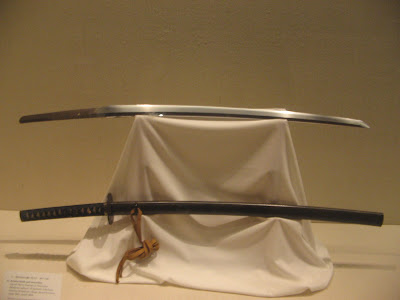The two combatants come together with a echoing report. Solid, sharp, it tells of the strength and purpose in each swing.
"Thwack!"
The swords hit home against head and torso, arm and shoulder. Neither opponent slows, but circles the other with precise steps. Recalling practiced movements, each searches for an opening, searches for that one strike that could give them the edge.
"THWACK!!"
Time!
The battle is ended. The two separate with a salute.
This trial of arms does not take place on the ancient sands of the arena, nor across the smooth stones of a temple's training grounds. The swords are not weapons of death. The arena is a gymnasium in the heart of Watertown, Massachusetts. The two-handed synthetic practice swords are capped with red rubber. This is the combat of the students of the Boston Chapter of the Schola St. George.
This Boston branch of the Schola St. George is school of medieval mixed martial arts and artists who use the teachings of the 14th Century Italian Grand Battle Master Fiore Liberi and his manuscript (the third oldest medieval fighting manuscript in existence) "The Flower of Battle," to train in the ways of the L'Arte di Armizare (Western fighting arts).
"Fiore's work really shows an entire system, from unarmed grappling up through mounted combat, complete with cross-references," said Charles Deily, Instructor at the SSG Boston. "As a teacher, I'm amazed by the pedagogy of his works, and shocked by the efficiency, though I shouldn't be. I've played with other systems (German, Japanese, modern fencing) but L'Arte d'Armizare really seems to speak to me."

In 2006, Deily sought out other members of the European martial arts community over the Internet. He came upon the home page of the Schola St. George and found their training style and their interpretation of Western Martial Arts to be the right fit. Convincing a few of his colleagues to “play with him,” SSG Boston was born.
Under the tutelage of Deily and others, the students of SSG Boston focus on a very specific curriculum from “The Flower of Battle:”
- Sword in Two Hands incorporating the movements of the Zogho Largo (long play with intricate sword movement and body turns) and the Zogho Stretto (Long play with integrated basic falling and locking skills, vital body mechanics, strikes, and guards)
- Fiore’s Daga (Dagger) techniques
- Azze (Poleaxe)
- Abrazare (Medieval Italian grappling)
Studying these arts students attain the skills they need to rise in the rankings of the school.
- Compagni (Beginner)
- Scolaro (Student)
- Magistro or Instruttore (Teacher or Master)
But like any martial art, the journey to Magistro (Master) take takes years of practice and perseverance. The tests are difficult and sometimes dangerous, as Deily has reported occasional wrenched arms and a hairline fractures, but what students get in return is not only a mastery of a deadly martial art but also the mastery of themselves.
“I've learned a lot about myself doing this,” said Deily. “It’s not just how bodies move and attack, but how lines of strength and lines of weakness relate, how to train calmly to deal with stress, how minor adjustments can make the difference between something failing and succeeding, and how to just be a better person.”
As students transform themselves into warriors through Western Martial Arts, they attribute their improvements to the essence of what is known as the chivalric code. In ancient days of the medieval knights of Europe, the chivalric code was a set of moral standards that a warrior would live by while he developed his dexterity in arms. Chivalry embodied the ability to steer dangerous people toward a social good through ideals such as courtesy, generosity, and valor. The SSG Boston encourages its students to develop their own code of combat through fair fighting, control of their weapons, and diligent study of not only the form and movements, but the language of Fiore as well.
But not everything at the SSG Boston is grueling martial training and tests, semi-hazardous swordplay, and knightly lessons. The members of the SSG Boston know how to have a great time both in and out of the gym. They spend nights out with one another, become friends, and form bonds that can often only fighters-in-training can know.
“Fiore uses the word "Compagno" (companion) for your training partner, which is literally someone you'd share bread with, and we try to think of our partners positively,” said Deily. “We do hang out together, often over dinner, or an evening resting and rehydrating our tired bones. I usually feel at home with people from other Schola groups as they are like-minded people, in less than five minutes. But having successfully tested with someone else just increases that bond.”
The SSG Boston invites everyone, men and women, to come be a part of the experience. Lessons cost $10.00 per session, $35.00 annual dues, with loaner equipment available for the first few lessons. Meetings are held every Thursday night from 7:00pm to 9:45pm at 57 Stanley Avenue, Watertown, MA, 02472 and at various times on Saturday mornings at Robbins Farm on 53 Eastern Avenue, Arlington MA.
Next time someone says chivalry is dead, tell them “No, it’s living in Watertown at the Schola St. George.”





























































